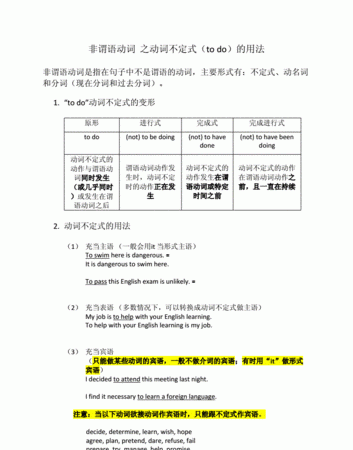本文目录
动词不定式的用法总结及例句
动词不定式(to do)是英语课的一个重点,也是很多考试中要考查的一个项目。你知道动词不定式的用法有哪些吗?接下来,我给大家准备了动词不定式的用法 总结 ,欢迎大家参考与借鉴。
▼▼目录▼▼
动词不定式的用法总结
名词的所有格形式
英语动词不定式短语
● 动词不定式的用法总结
动词不定式属于非谓语动词的一种形式,很多同学经常把它和谓语动词混在一起,掌握起来有困难。下面我们对动词不定式的用法做简单归纳,帮助同学们记忆:
一、动词不定式在 句子 中不能充当谓语,没有人称和数的变化。
二、动词不定式是由“to+动词原形”构成(有时可以不带to)。动词不定式的否定形式是“not+动词不定式”(not不与助动词连用)。
三、动词不定式 短语 具有名词、形容词和副词等的功能,可在句中用做多种句子成分。
1、主语:常置于句末,而用it代替其做形式主语。例:
To go in for sports helps you
stay fit.(book4,L28)
It helps you stay fit to go in for sports. It is dangerous to swim in the deep sea on your own.
注:此句式中不定式逻辑上的主语可由for或of引出,逻辑主语由of引出时,表语的形容词为kind,nice,good,polite,clever,foolish,right,wrong等表示评价的形容词。
例:It's right of him to refuse the invitation1.(him为逻辑主语)
2、表语:Our duty is to protect the enviroment.
3、动词宾语:此种情况可按固定搭配或句式去记。
例:would you like to see my photos?
Kevin planned to visit his uncle.(book4,L11)
和plan用法一样的词还有:start,want,agree,hope,begin,decide等。
I found it very difficult to get a job.(it为形式宾语)
4、宾语补足语:
(1)在多数复合宾语及物动词后要带to。
例:I asked a friend to read it to me.(book4,L2)
(2)在表示感觉、致使等意义的动词(see,watch,hear,feel,notice,observe,make,let,have,help等)后不带to。
例:They heard him sing a pop song in the meeting room.
5、定语:动词不定式做定语放在所修饰的名词的后面。
例:Vinny is the first disabled2 person to sail3 around the world.(book4,L1)
6、形容词补足语:在表示心理、感情、评价等的形容词后,对其进行补充说明。
例:Weareverygladtomeetyouagain.
7、状语:表示目的、原因、程度等。
例:They brought in photos of their families for me to look at.(book4,L2)
8、“疑问词+不定式”用法:不定式前可带what,who,which,where,when,how等疑问词,这种不定式短语在句中多用做宾语。
例:He didn't tell me where to go.
9、在初中阶段还涉及到“不定式被动语态一般式(tobe+过去分词)”。
例:There are twenty more trees to be planted.
>>>
● 扩展: 名词的所有格形式
A. 's用在单数名词以及不以s结尾的复数名词之后:
a man's job 男人的活儿
the people's choice 人民的选择
men's work 男人的工作
the crew's quarters 船员的舱房
a woman's intuition 女子的直觉
the horse's mouth 马嘴
the butcher's(shop) 肉店
the bull's horns 公牛角
the child's voice 孩子的声音
women's clothes 妇女的服装
the children's room 孩子们的房间
Russia's exports 俄国的出口
B .省字撇(')用于以s结尾的复数名词之后:
a girls' school 一所女子学校
the students' hostel1 学生招待所
the eagles' nest 鹰巢
the Smiths' car 史密斯家的小汽车
C. 以s结尾的古希腊或罗马的姓名之后通常也只加省字撇('):
Pythagoras' Theorem 毕达哥拉斯定理
Archimedes' Law 阿基米德原理
Sophocles' plays 索福克勒斯的戏剧
D. 以s结尾的其他姓氏之后可以用's或单独使用省字撇('):
Mr Jones's/Mr Jones' house琼斯先生的房子
Yeats's/Yeats'poems叶芝的诗
E. 复合名词是在最后一个词之后加's以构成其所有格形式:
my brother-in-law's guitar我姐 /妹夫的吉他
由几个词组成的名字可同样处理:
Henry the Eighth's wives亨利八世的妻子们
the Prince of Wales's helicopter威尔士王储的直升机
's也可用在首字母缩写词之后:
the PM's(Prime Minister's) secretary首相的秘书
the MP's(Member of Parliament's) briefcase议员的公事包
the VIP's(Very Important Person's) escort要人的护送(摩托)队
注意:使用所有格形式时,“被拥有的”人或物之前的定冠词就不用了:
the daughter of the politician=the politician's daughter这位政治家的女儿
the intervention of America=America's intervention美国的干预
the plays of Shakespeare=Shakespeare's plays莎士比亚的戏剧
>>>
● 英语动词不定式短语
1.It's time to do sth./It's time for sth 该做某事的时候了
eg:Now it's time to sing alone. 现在是独自唱下去的时候了。
2.can't wait to do sth. 迫不及待要做某事
eg:We can't wait to have a try. 我们等不及想要常试一下了。
3.Ask/tell sb. (not ) to do sth. 要求/告诉某人(不)做某事
eg:Did I not tell you to help robbery/homicide? 难道我没有告诉你要去协助调查抢劫谋杀案么?
4.Allow sb. to do sth. 允许某人做某事
eg:As long as I am alive, I'll not allow you to do that.
只要我活着就不允许你做那件事。
5.Be supposed to do sth. 应该做某事
eg:I did everything right, everything I was supposed to do.
我做的一切都是正确的,我做了一切我该做的事。
6.Would like/want (sb.) to do sth. 想要做某事
eg:I would like some coffee. 我想要一点儿咖啡。
7.Have sth/nothing to do 与……有关/与……无关
eg:This thing has nothing to do with you. 这事和你一点关系也没有。
8.find it +adj. to do sth. 发觉做某事……
eg:I find it difficult to live with him. 我发现跟他生活在一起是很困难的。
9.Prefer to do sth. rather than do sth. 宁愿做某事,而不愿做某事
eg:I prefer to do hard work rather than do nothing at home.
我宁愿干重活而不愿在家无所事事。
10.It's +adj. for sb. to do sth. 做某事对某人来说……
eg:It's difficult for women to get jobs in high position.
对妇女来说得到一个高职位的工作是很难的。
11.It's better/best to do sth. 最好做某事
eg:Generally, it's better to apply filler materials in thin layers.
一般来说,最好适用于薄层填充材料。
12.It takes sb/sth. to do sth. 某人做某事用了一些时间
eg:It takes some time to cultivate a new friendship. 建立一段新的友谊需要一段时间。
>>>
动词不定式的用法总结相关 文章 :
★ 不定式作宾语用法总结
★ 初中英语不定式知识点归纳
★ 不定式作状语的用法总结
★ 动词不定式是如何否定的
★ 不定式的特殊句型too…to…的用法
★ 英语动词知识讲解:6类动词的用法
★ 非谓语动词用法总结
★ 英语语法知识点总结
★ 英语基础语法知识点总结:动词的时态
★ 英语动词的语法归纳
var _hmt = _hmt || []; (function() { var hm = document.createElement("script"); hm.src = "***/hm.js?fff14745aca9358ff875ff9aca1296b3"; var s = document.getElementsByTagName("script")[0]; s.parentNode.insertBefore(hm, s); })();
动词不定式的用法总结及例句
1、动词不定式作主语
可以直接把动词不定式放在句首,特别是带疑问词的不定式短语作主语,要经常放在句首。但是通常来说,特别是不定式短语很长的时候,为了避免头重脚轻的状况,用it做形式主语,而把真正的主语(也就是动词不定式)放在句末。
2、动词不定式作宾语
有些及物动词用不定式做宾语,构成“动词加不定式”,不仅可以用不定式作宾语,还可以做补语,构成“动词加宾语加不定式”的形式。例如:afford(付得起),agree(同意),aim(力求做到),appear(显得)3、动词不定式作宾语补足语
可以分为两种情况:
一种是带to的动词不定式做宾补,
另一种是主动语态里不带to,而变为被动语态那时候要加上to 。

4、作表语
不定式作表语表示具体动作或将来动作;动名词作表语表示抽象的一般行为。
例句:My chief purpose is to point out the difficulties of the matter.
我的主要目的是指出这件事的困难。
5、作状语
如果不定式为不及物动词,其后应有必要的介词。当动词与介词连用时,常位于“形容词+动词不定式”结构的末尾。
动词不定式的用法
动词不定式用法总结 动词不定式在句中可充当主语、表语、宾语、宾补、定语和状语等。
一、作主语
动词不定式作主语可位于句首。例如:
To learn a skill is very important for everyone in society.
也可使用it作形式主语,而将其置于句末。例如:
It is necessary for young students to learn a foreign language.
动词不定式作主语的常用句型有:
1. It is+adj./ n. (+for sb./sth.) + to do sth.
用于此句型的形容词有:easy, hard, difficult, possible, important, impossible, necessary, good, bad, exciting, interesting, surprising等。例如:
It is interesting to play this game.
It is necessary for you to change your job.
It was impossible for them to complete the task in such a short time.
考例1:Is ____ possible to fly to the moon in a spaceship? (88 MET)
A. now B. man C. that D. it
用于此句型的名词有:pity, shame, pleasure, one’s duty, one’s job, fun, joy, good manners, bad manners等。例如:
What a pity it is for you to have missed such a wonderful film.
It is good manners for the young to give their seats to the old.
2. It is+adj.+of sb.+to do sth.
该句型中只能使用描述某人的品德、特征的形容词,如: kind, nice, wise, silly, polite, impolite, friendly, foolish, clever等。例如:
How rude it was of the boy to jump the queue!
It is friendly of the family to try to make me feel at home in their house.
How silly it was of you to give up such a good chance!
3. It takes sb.+some time+to do sth.
该句型意为“做某事花费某人多长时间”。例如:
It took us half an hour to ride to the town by bike.
二、作表语
动词不定式作表语常用于以下结构:My wish/ job/ aim/ goal is…及The next step/ measure is …等。例如:
Your job is to type the papers in the office.
The next measure is to stop the river from being polluted.
三、作宾语
常见的只能使用动词不定式作宾语的动词有:agree, choose, decide, hope, fail, wish, refuse, expect, manage, plan, intend, pretend, promise, offer, afford, demand, arrange等。 例如:They decided to build a highway between these two cities.
She offered to help me when I was in trouble.
believe, think, consider, feel, make等动词可用于“动词+ it +adj. / n+to do sth.”句型,其中使用it作形式宾语,而将真正的宾语动词不定式置于句末。例如:
I think it necessary for us to have a good rest after the long work.
She felt it her duty to help the old woman.
四、作宾补
可后接动词不定式作宾补的动词有:advise, allow, ask, hear, order, see, tell, want, wish, watch等。例如:
The doctor advised her no to eat too much sugar.
I wish you to go to the meeting with me.
believe, consider, count, declare, deny, feel, find, guess, imagine, judge, know, prove, realize, suppose, think等动词后可接to be型不定式作宾补。例如:
He declared himself to be a college student. 他自称是名大学生。
The police proved him to be a thief. 警察局证实他是小偷。
hope, demand, suggest等动词不能后接动词不定式作宾补。例如:
【误】I hope my son to be back soon.
【正】I hope my son will be back soon.
【误】She suggests us to have a discussion about it.
【正】She advises us to have a discussion about it.
【正】She suggests that we (should) have a discussion about it.
在主动结构中,下列动词后作宾补的动词不定式应省略to:“五看”(see, watch, notice, observe, look at)“三使”(make, let, have)“两听”(hear, listen to)“一感觉”(feel)。例如:
Who made him work all night long?
但是,改为被动结构后,应补出省略的to。例如:
He was seen to break the window.
五、作定语
动词不定式作定语,应位于所修饰词语之后,即:作后置定语。例如:
Have you got anything to eat? (to eat修饰anything,位于其后)
下列名词后常接动词不定式作定语:ability, attempt, chance, courage, decision, effort, failure, promise, way, wish等。例如:
But she gave up the chance to go abroad.
由only, first, last, next以及序数词或形容词最高级修饰的名词后,也常接不定式作定语。例如:
Who was the last one to leave the classroom last night?
六、作状语
动词不定式作状语,可表示目的、原因、结果或条件。例如:
We went there to see our grandparents.(目的)
I am very sorry to hear that.(原因)
She hurried home only to find her father dead.(结果)
To look at the picture, you would like it.(条件)
作目的状语,还可以使用in order to或so as to。例如:
The boy worked so hard in order to make up for the lost time.
结果状语还可以使用enough to, too…to…, so…as to, such… as to等结构。例如:
He got up too late to miss the early bus.
She was in such a hurry as not to notice me. 她如此匆忙,以致没有注意到我。

动词不定式的用法总结及例句
1、动词不定式作主语
可以直接把动词不定式放在句首,特别是带疑问词的不定式短语作主语,要经常放在句首。但是通常来说,特别是不定式短语很长的时候,为了避免头重脚轻的状况,用it做形式主语,而把真正的主语(也就是动词不定式)放在句末。
2、动词不定式作宾语
有些及物动词用不定式做宾语,构成“动词加不定式”,不仅可以用不定式作宾语,还可以做补语,构成“动词加宾语加不定式”的形式。例如:afford(付得起),agree(同意),aim(力求做到),appear(显得)。
3、动词不定式作宾语补足语
可以分为两种情况:一种是带to的动词不定式做宾补,另一种是主动语态里不带to,而变为被动语态那时候要加上to 。

4、作表语
不定式作表语表示具体动作或将来动作;动名词作表语表示抽象的一般行为。
例句:My chief purpose is to point out the difficulties of the matter.
我的主要目的是指出这件事的困难。
5、作状语
如果不定式为不及物动词,其后应有必要的介词。当动词与介词连用时,常位于“形容词+动词不定式”结构的末尾。
以上就是关于动词不定式6种用法总结 ,动词不定式的用法总结及例句的全部内容,以及动词不定式6种用法总结 的相关内容,希望能够帮到您。

